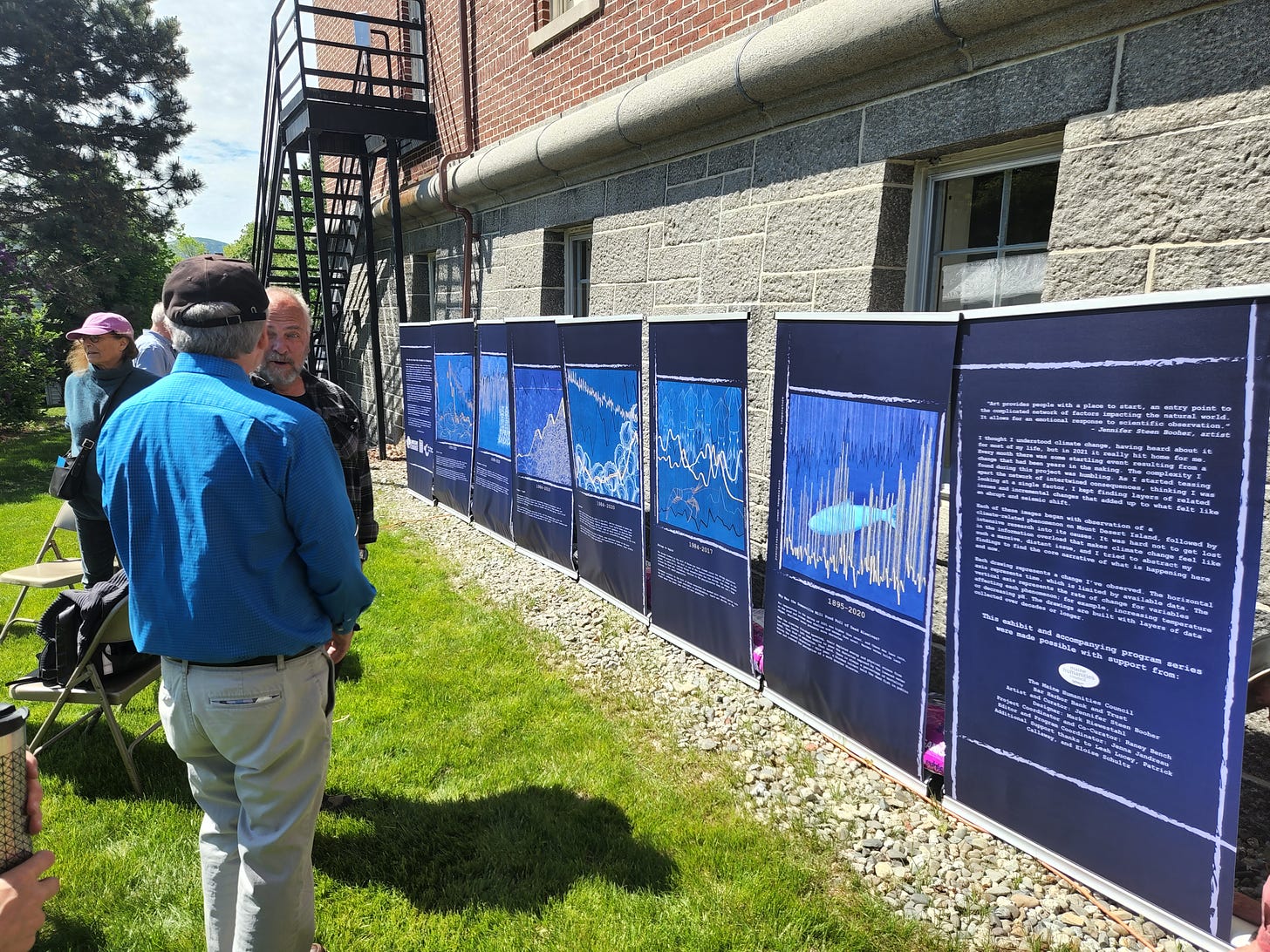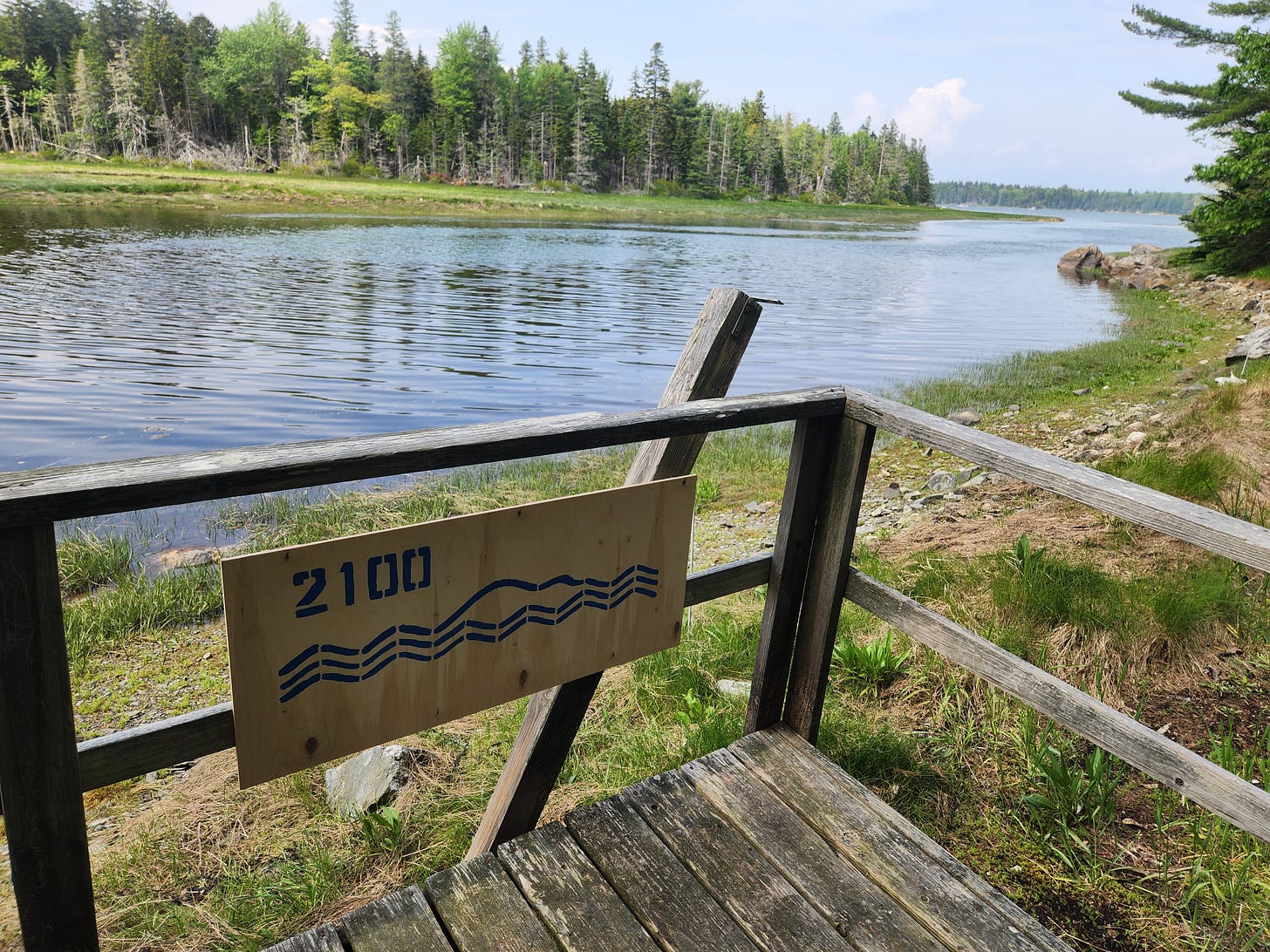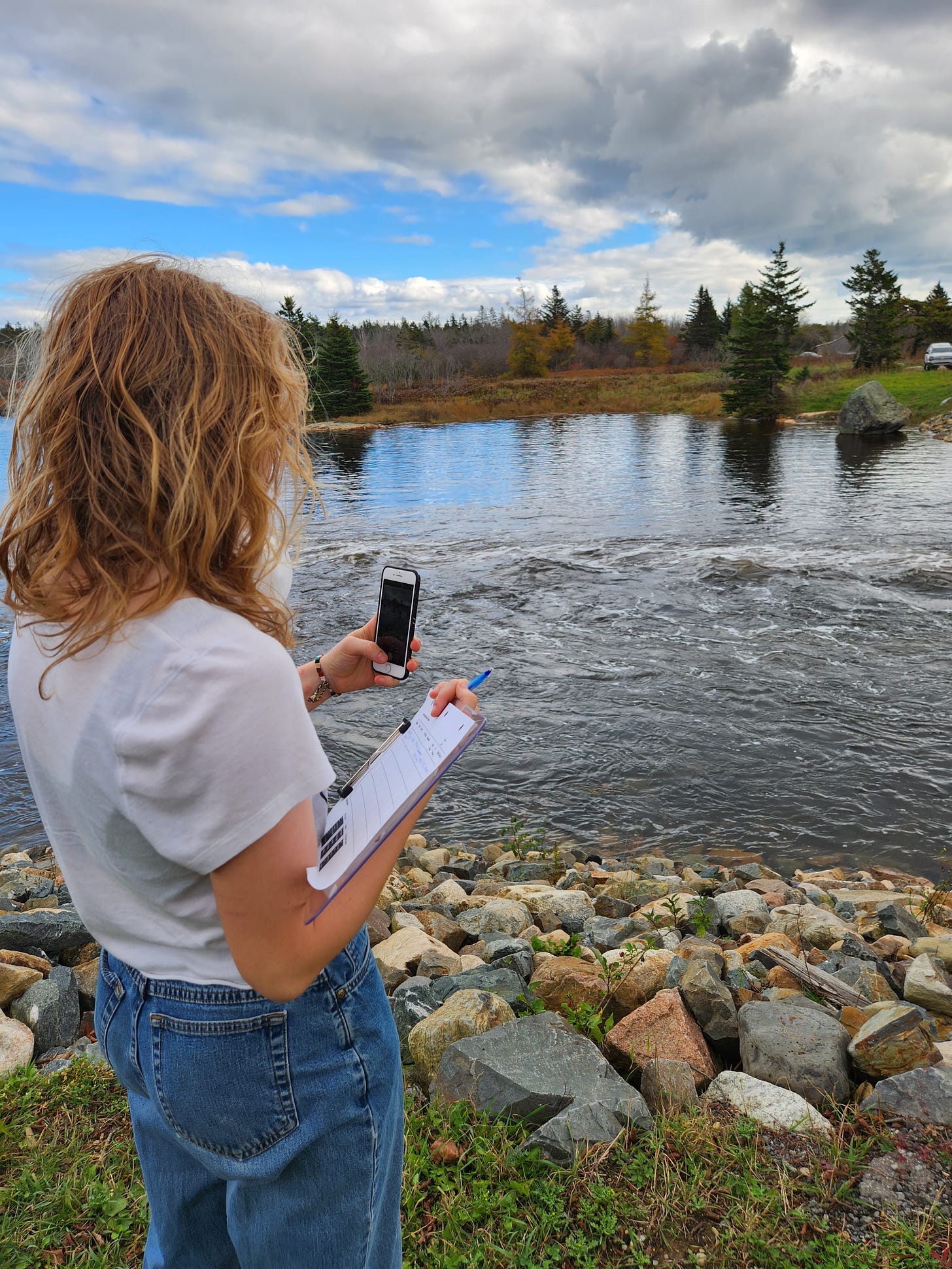Tiny Historical Society Leads Local Climate Action
Pulling Together on Mount Desert Island in Maine
For many history museums, the mission boils down to “history is a lens for understanding today and planning for tomorrow.” Which makes it easy to see the mission tie to urban/regional planning in arenas like economic development, housing and transportation, city design, civic engagement, and justice. But increasingly, history museums and historical societies are finding a role in climate resilience and sustainability planning. As the marketing blurb for Sarah Sutton’s book Environmental Sustainability at Historic Sites and Museums notes, the public’s increasing climate awareness “is an invitation to use our knowledge, collections, and sites to discuss how human practices and interactions with the environment in past were – and were not – environmentally sustainable.” One small example comes from the urban heat island mapping project by the Science Museum of Virginial I’ve mentioned in a past post. It was someone from the local history museum, the Valentine, who first mentioned to SMV’s project manager, Jeremy Hoffman, that the heat island maps looked a lot like the city’s historic redline maps.
Today, I want to focus on the on-going Landscape of Change project by the tiny Mount Desert Island Historical Society. Apologies that this is long - it’s a worthy project, I promise. And for those outside of New England, I should set the stage a bit. My fellow Yankees can probably skip the next two paragraphs.
Mount Desert Island (“MDI”) is closer to the Canadian border than to Boston. It is the home to Acadia National Park which has an annual visitation of 4 million. Beyond hosting park visitors, MDI, like Nantucket and Martha’s Vineyard, sees its population swell seasonally as One Percenters return to their vacation homes to “summer.”
Traditionally, small New England towns are fiercely independent. Many are still run by Town Meeting1 and elected and appointed positions are predominantly unpaid. County governments do exist but have very limited functions – operating things like courts or jails; they rarely have a role in coordinating between municipalities. Now add to the mix that the Gulf of Maine is one of the fastest warming bodies of water on Earth, putting unpredictable squeezes on local fishing and shellfishing businesses, and projected to raise average sea levels by three feet by 2100. Against this backdrop, each island town, with year-round populations between 1000 – 5000, is working on its resilience plan, without any formal government infrastructure for collaboration.
Climate Data in the Collection
Among those who “summered” on MDI in the early 19th Century were Harvard students of the Champlain Society who conducted amateur but systematic natural history research on the island. Dividing themselves into different science specialties, the society returned annually from 1880 – 1889 to record the geology, tides, weather, and to observe and collect plants and animals, both terrestrial and aquatic. While the Champlain Society’s specimens sit in a Harvard collection, its logbooks are part of Mount Desert Island Historical Society’s collection. In the late 2010’s, the MDI Historical Society was able to get the Champlain logbooks digitized through the Maine Memory Network. The logbooks soon caught the eye of scientists in the area, especially those studying local impacts of climate change.
By the time Raney Bench started as the Historical Society’s Executive Director in January 2020, it was clear that the logbook data needed to be the impetus for a more proactive collaboration with climate researchers, and for much broader, cross-island engagement in taking climate action. The Museum’s resulting project, Landscape of Change, “is a collaborative project using history, science, and imagination to document and communicate the scope, speed, and scale of climate change on MDI.”

The ongoing project has produced:
New climate impact data thanks to several community science bio-blitz events in Acadia, including observations taken at the same sites documented in Champlain Society logbooks and in other historic records;
Art installations that make historic and contemporary data accessible and emotionally evocative;
Exhibitions at the MDI Historical Society, in the lobby of the local movie theater, Reel Pizza, and at the island’s Oceanarium, and a traveling exhibit that the Society displayed at events and in a variety of island locations;
Interactive ArcGIS maps of 1900 – 1950 data from multiple historic sources, including the Champlain Society;
A new and growing list of heavy-hitting partners for the museum including a local climate action organization, A Climate to Thrive, Acadia National Park and its affiliated nonprofit research learning center, Schoodic Institute, the College of the Atlantic, and the Mount Desert Biological Laboratory.
I cannot do the project justice here, so please take some time to explore the project website for some big time inspiration, but I can share a few of the lessons that planning-curious museum people can take from the project.
Partnerships to Build Cohesion
Cross-island cohesion is in the Society’s DNA already. To make clear that it serves the entire island, it lists Board members’ hometowns, rather than their professional affiliations. Similarly, their partners’ island-wide or regional focus add more layers of connection and channels of communication. The project’s emphasis on community science (formerly “citizen” science) and its tie to the Champlain Society’s historic data gave locals of all ages different avenues into participating in the project.
Best Practices in Building Climate Literacy
My favorite part of this project is that the museum is instinctively following current best practices in climate engagement, as laid out by resources such as NOAA’s Resilience Hub, Action for Climate Empowerment, and Project Drawdown’s Drawdown Review. For years, those of us in science-related museums tried to counter climate denialism with a barrage of Facts, to the point that we have contributed to the Hope Gap in the public that now fears that it’s too late to save the planet.
“One of the things you learn pretty quickly is that your instincts about how to communicate about this issue probably are not correct.”
~ Billy Spitzer, New England Aquarium, quoted in Reframing Climate Change by the Frameworks Institute
When I mentioned to Raney how well the museum was acting on best practices, she was pleasantly surprised. As non-science professionals, museum staff and board were moved forward by good old common sense. Instinctively, they wanted to present data in a way that anyone could understand. Raney explained that the staff were thinking as parents who wanted to take meaningful action to secure their children’s future. They knew they wanted to “move beyond trite ‘solutions’” like ‘recycle more’. And that they wanted to help people engage deeply with the land and sea.
Here are some of the best climate engagement practices that Landscape for Change project follows:
Focus on Local Impacts
The museum is teeny - tiny – just two full-time staff – so it is nimble. Each year’s focus topic is entirely driven by community interests and events. Sea level rise nominated itself as the 2023 theme when flooding during December 2022 storm visibly demonstrated what average future sea levels will look like. The museum has a tradition of presenting timely historic context in response to local issues, such as offered a talk on the history of local salmon fishing and sea-pen farming as locals were fighting a commercial salmon farm proposal. So, responding to local climate-driven events isn’t so much a pivot as the normal course of action.

Raise the Collective Climate Literacy
In its Community Resilience Education Theory of Change, NOAA talks about the importance of creating a “collective environmental literacy”, pointing out that “not all individuals in a community must have the same level of environmental literacy, but there is a level of collectively held environmental literacy necessary to be resilient. However, Landscape of Change noted that “not all people will understand, be interested in, or believe the science of climate change. Art, story, history, and music can translate the complex language of science and evoke an emotional response to the data.” Hence the original art exhibits, a community-driven outdoor exhibit, guerilla art marking future sea level rise, musical performances, and webinars. Also, each partner organization has linked project webpages, greatly increasing the chance that different people can find their own way in to learn more.

Offering Social, Active Learning Opportunities and Collective Solutions
This is another of NOAA’s climate engagement tenets. While anyone could participate in the community exhibit, the science-minded folk could collect important data. Local high school students worked with the Schoodic Institute to document high tides and worked with Landscape of Change artist Jennifer Steen Booher to communicate what they learned to the public. (Involving and empowering youth to give them the tools and confidence to help design and implement solutions, and to speak to and collaborate with adults is another best practice mentioned in most climate communications guides, so the high school project is a two-fer.)
While social and active learning is great for the extroverts and outdoorsy folks, I would add that introverts and the not-necessarily nimble should find a welcome too. Landscape of Change partner A Climate to Thrive does a lovely job showcasing a small diversity of “Climate Superheroes” on its Action Hub, including a retired grant writer who helps secure project funding.
Impart Hope; Inspire Civic Engagement
The FrameWorks Institute recommends emphasizing collective action because it “takes advantage of Americans’ self-perception as people who roll up their sleeves and get to work when faced with a challenge. This framing encourages advocates to adopt a more fully elaborated call for help—from ‘Fire!’ to ‘We have a fire! Bucket brigades work. Let’s get creative. Join us here!’”
Landscape of Change does exactly this. The project’s Story Map page is infused with language that Imparts hope and offers ways to participate with others:
“You can help us document Mount Desert Island’s changing landscape.”
“To build a resilient future, we are developing three interrelated skill sets shared by our community: paying attention, connecting, and taking action. When combined, these three tools enable us to respond to extreme weather events, economic shifts, and other unforeseen challenges” (emphasis added). And it offers upbeat, actionable descriptions of how people can pay attention, connect and take action.
Encouraging Take Aways
If you’re having trouble getting your institution to take bold steps on climate work, there are increasing numbers of examples to point to. But some of the take aways from the Landscape of Change pertain to the specific concerns of small history museums.
Size Does NOT Matter
I know that not every tiny history museum is in the position to launch something this large. Raney notes that she had Board support for the project, in part because they knew “we punch way above our weight.” But she also has a soapbox speech that every little institution needs to hear: “No matter your size, you have meaningful things to contribute.” Couple that with finding local partners who can do what you can’t do and can benefit from what you can, and you too can go farther than you think.
The Money Came
The Board and staff understood that some donors might walk away; one did vocally, a few others might have left quietly. But those losses were more than offset by new donors who gave specifically because they saw the importance of the project.
So Did New Opportunity
The project has given the museum new traction and visibility across the island. While raising climate literacy, and thereby creating new trusted climate messengers around the island, the Historical Society is raising its own value as a trusted messenger itself. This increasing civic legitimacy has led them to be invited to join local housing initiatives, specifically because they can bring historical context to the table, showing how the past has shaped today’s housing landscape.
After reviewing a draft of this post between flooding January storms, Raney wrote to me:
“As I 'drown' in storm work from last Wednesday and prepare for a new round of inundation tomorrow, it feels all the more timely. Our outreach to the community to collect images and stories from these storms and linking it to existing work on sea level rise has already brought us new fans, resulted in many expressions of gratitude, and been shared far wider within the island community than any previous outreach. We're now in the process of planning a series of community suppers to record stories about impacts to the working waterfront from multi-generational working families, and we will be updating our sea level rise communication and activities for 2024 to specifically reference what one additional foot of sea level rise looks like, where the island is vulnerable, and what specific actions we can take to be prepared in the future. The damage here is so sad, but the opportunity to coalesce through a shared experience could be the silver lining. No one can argue we're at the mercy of the sea.”
You may not be next to the sea, but your community is at the mercy of an ever angrier Mother Nature. Here’s hoping that this project offers lessons that you can use to convince your museum to get bravely involved.
Many thanks to Raney for all of her time, insights, and photos!
~ Betsy Loring2
The Planning-Curious Museum Person
Sharing stories and ideas for other Planning-Curious Museum People and for Museum-Curious Planning People.
If you’re not familiar with the term, Town Meeting, without getting into the weeds, is very direct democracy. The meeting is open to all voters in town and is the legislative authority of town government, not the elected officials (usually called the Select Board). We voters sit there in the biggest school auditorium in town (usually over several nights), debating and voting on the agenda, which includes the annual budget. Fire Department need a new pumper? School building need a new roof? It’s got to pass at Town Meeting. As communities grow and these open town meetings get too impractical, they switch to other forms of government that you’re familiar with, but in small New England towns, town meeting is still extremely common.
Betsy Loring is founder of expLoring exhibits & engagement. She has over 20 years’ experience in project management and exhibit development in multidisciplinary, indoor and outdoor museum settings. Her services include exhibit master planning, content and interactive development, and writing, with a focus on hands-on STEM. She also offers staff training in exhibition planning, formative evaluation, and prototyping. Special interests include multi-institutional collaborations, peer-to-peer professional development, and of course – collaboration with municipal planning practitioners.



